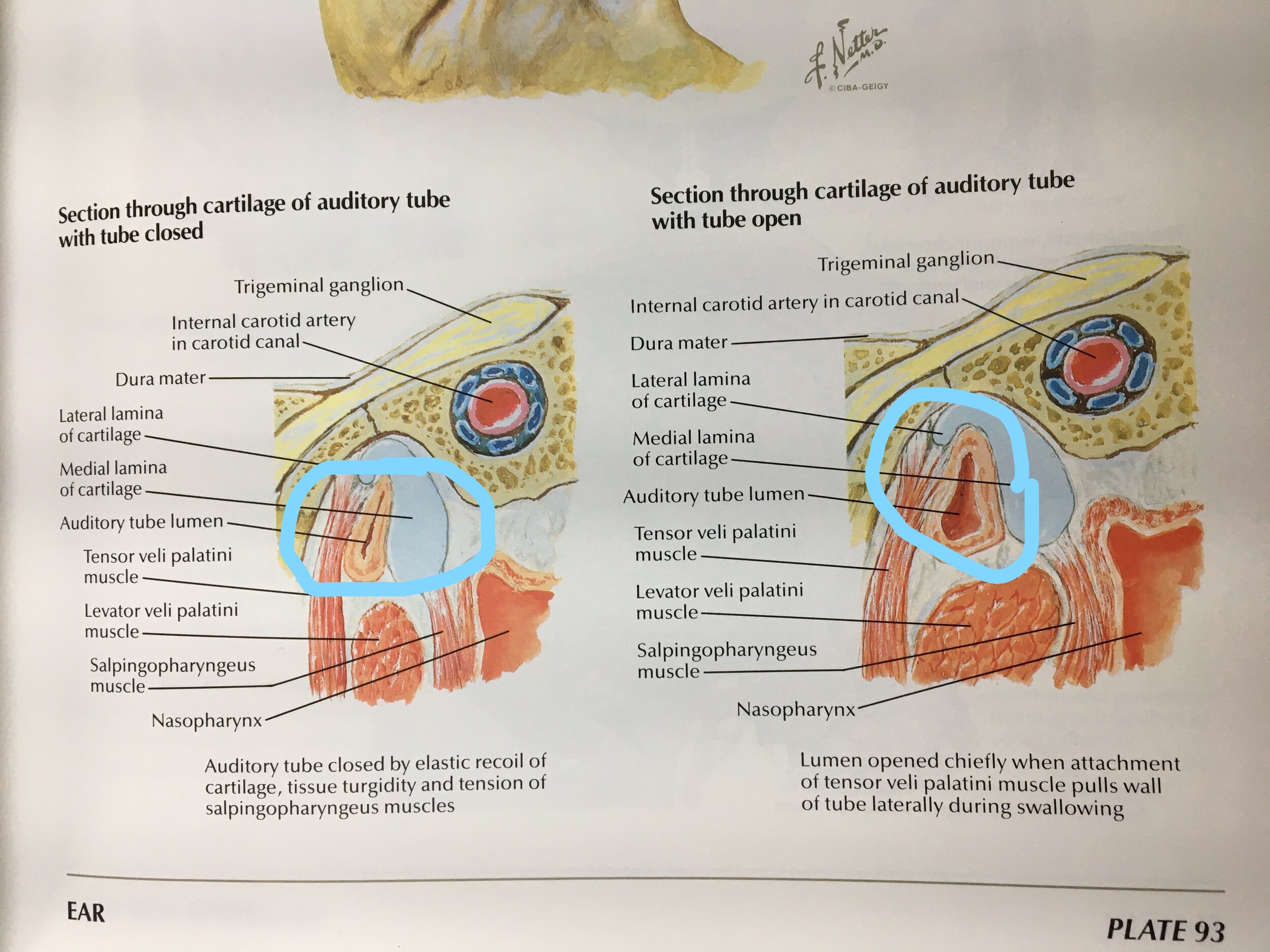Ear, sinus, and balance symptoms related to Safe and Sound Protocol use
( All images are from F. Netter’s Atlas of the Body, 1995)
Ear complaints: strain, popping, fullness, tinnitus, dizziness
What’s happening?
The SSP stimulates the vagus nerve, starting in your ear. Branches of the vagus nerve control the muscles that close and open your Eustachian (auditory) tubes. The levator veli palatine muscle opens your Eustachian tubes. It is attached on one end in your middle ear at the back of your palate on the other end. This muscles is involved in swallowing, which is why swallowing or compressing your tongue is related to causing your ear pops. “Popping” in your ears results from changes in the ear pressure when the Eustachian tubes open.
Eustachian tubes also manage the drainage of fluid from your ear, which gets rid of dead cells that are part of regular “clean up” in the body. Drainage from the middle ear helps to equalize pressure changes by regulating the fluid. Also, fluid in the ear shifts to adjust for postural changes (for example: standing up; lying on your side).
The ear ‘mechanism’ is located inside the skull
Drainage can’t happen when your Eustachian tubes are clogged due to infection, or because the controlling muscle is contracted. Fluid collects, which harbors inflammation and disrupts the shifting of fluid to establish your sense of balance. A sense of dizziness results when there is a sudden change in fluid levels due to the relaxation of the muscle, opening of the Eustachian tubes. If you have gotten used to living with ‘clogged’ Eustachian tubes, this change will take some time to adjust as your body relearns what its proper level.
Interestingly, when you realize something that profoundly shifts your understanding of what is happening (or has happened), you can get a sense of dizziness or disorientation. People have these kinds of experiences more often 2-6 weeks AFTER completing the SSP. People ‘rewrite their self-narrative’ as they realize key understanding about how they have explained the past to themselves. It appears that changing our understanding can provide physical experiences that mirror those related to balance.
The Eustachian tubes drain into your nasal sinus. Sometimes the tubes can also be ‘too open’, and waste material from your nasal sinus flows back into your middle ear, causing an infection. If you have a history of ear problems related to sinus infections, this could be what is happening.
The salpingopharyngeus muscles help to keep the Eustachian tubes closed. These muscles are attached to the Eustachian tube on one end, and the palate on the other end, and are involved with chewing and swallowing.
The SSP tends to bring the tension in all of the muscles of your face and head back into balance. People report that they stop clenching their jaw, can turn their head from side to side more freely, and have greater ease in swallowing.
How to reduce ear symptoms when taking the SSP:
A. Reduce the volume
B. Reduce the amount of listening time or take breaks while listening
C. Warm packs on the neck to encourage relaxation
D. Sucking of ice chips to reduce nausea
E. Rosenberg’s Basic Exercise to encourage release of tiny muscles related to eye/palate
EX YouTube Video: (https://www.youtube.com/watch?v=cHkrwSUFydc)
F. EFT tapping exercises (on YouTube: https://www.youtube.com/watch?v=XRfLTQjJhp0 )
G. Mindfulness and breathing (for example: https://www.youtube.com/watch?v=SEfs5TJZ6Nk)
H. Yoga postures, such as downward dog (https://www.youtube.com/watch?v=W12PdhF5AuE)
I. Massage starting 2 weeks AFTER completing the SSP (especially cranio-sacral)
J. Acupuncture starting 2 weeks AFTER completing the SSP



